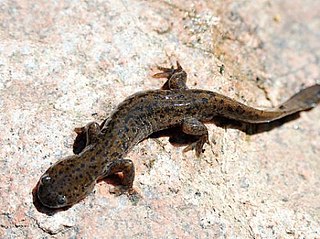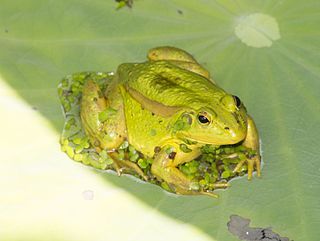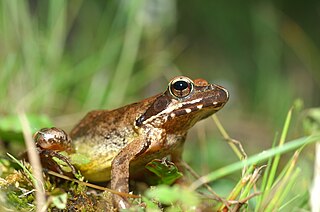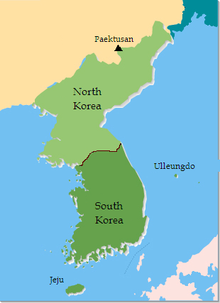
The Korean salamander, or Gensan salamander, is the most common species of salamander on the Korean peninsula, and is also found and on Jeju Island and in the north-eastern Chinese provinces of Liaoning, Jilin and Heilongjiang. It typically lives on forested hills, and from time to time mass deaths occur in Korea when salamanders encounter man-made drainage structures. This has prompted Korean government officials to execute a series of mass evacuations in heavily salamandered areas.

Hynobius yangi, the Kori salamander, is a species of salamander endemic to southeastern South Korea. It is a lentic-breeding species similar to the Korean salamander but is distinguished by factors including tail shape and dorsal coloration. The species is known from the vicinity of the type locality in Gijang County in northeastern Busan and from the nearby Ulju County in western Ulsan.

Hynobius quelpaertensis, the Jeju salamander, also spelled Cheju salamander, is a species of salamander found on various islands and peninsulas off the southwestern coast of the Korean Peninsula, including Jindo, Geojedo, Jejudo, and Namhae. It inhabits moist mountain forests.

The Seoul frog or Seoul pond frog is a species of true frog found on the southern and western Korean Peninsula to Shenyang, China.. It is closely related to the eastern golden frog, P. plancyi, and was long considered a subspecies thereof. Also known as gold-spotted pond frog, it is in fact not a true pond frog of genus Rana, but belongs to the water frogs now again separated in Pelophylax.

Rana amurensis is a species of true frog found in northern Asia. Rana coreana was previously included in this species as a subspecies.
The Huanren frog is a species of true frog found in East Asia. It was originally believed to be endemic to Huanren County, Liaoning, China, but was later also found in South Korea; it is presumed to be present in North Korea, as well. It is closely related to the Dybowski's frog, Rana dybowskii, and specimens collected before 1991 were incorrectly identified as that species. Distinguishing factors include the absence of a vocal sac.

Dybowski's frog is a species of true frog found in Northeast Asia. It is found in the Russian Far East, the Korean Peninsula, and the Japanese island of Tsushima. It may also exist in northeastern China, but this has not been confirmed.

Pelophylax nigromaculatus, is a species of true frog found in East Asia, first described in 1861. This widespread and common frog has many common names, including dark-spotted frog, black-spotted pond frog, and black-spotted frog.

The Hida salamander or Hondo salamander is a species of salamander in the family Hynobiidae, the Asiatic salamanders. It is endemic to central and western Honshu, Japan. It lives in deciduous, coniferous, and mixed forests, where it breeds in streams. The egg sacs of this species were reported to display blue-to-yellow iridescent glow due to a quasi-periodic diffraction grating structure embedded within the enveloppes of the egg sacs. These salamanders typically spawn from February to April, leading some to metamorphose in late September while others wait for the following year to do so after winter is over.

The Tokyo salamander is a species of salamander in the family Hynobiidae, endemic to Japan. Its natural habitats are temperate forests, freshwater springs, arable land, irrigated land, and canals and ditches. It is threatened by habitat loss. Many different species of amphibian have unbalanced sex ratios. This trend is no different in Hynobius Tokyoensis; the sex ratio between males and females is about 1.5:1. Although this does not play as large of a role as habitat destruction when it comes to the decline of this species, it is still significant. Considering their environmental preferences, they are usually found in paddy fields. Mid-Summer drainage from these fields hinders the population's ability to thrive as this would occur before these populations could complete metamorphosis.

The Amami tip-nosed frog is a species of frog in the family Ranidae. It is endemic to the Amami Islands, a part of the Ryukyu Islands, Japan. Specifically, it is known from the islands of Amamioshima and Tokunoshima.
Pelophylax demarchii is a species of frog in the family Ranidae. It is only known from its unspecific type locality, Eritrea. Its taxonomic status is unclear. Common name Eritrea pond frog has been coined for it.

The common green frog is a frog species of in the true frog family Ranidae; some sources still use the old name Rana erythraea. It lives in Southeast Asia and is also known as green paddy frog, red-eared frog or leaf frog. The last name, however, commonly refers to the Neotropical tree frogs which make up the subfamily Phyllomedusinae. These are not closely related to H. erythraea, belonging to family Hylidae instead.

The Daruma pond frog is a species of frog in the family Ranidae. It has two subspecies, P. porosus porosus and P. porosus brevipodus. It is endemic to Japan. The average size of males is 3.5 to 6.2 cm, while females are from 3.7 to 7.3 cm.

The Kampira Falls frog, also known as the Yaeyama harpist frog or harpist brown frog, is a species in the true frog family (Ranidae). Until recently known as Rana psaltes, it is found on Ishigaki and Iriomote in the Yaeyama Islands of Japan, as well as on Taiwan.

The Korean brown frog is a species of frog in the genus Rana. It is native to the Korean Peninsula and Shandong, China.


















